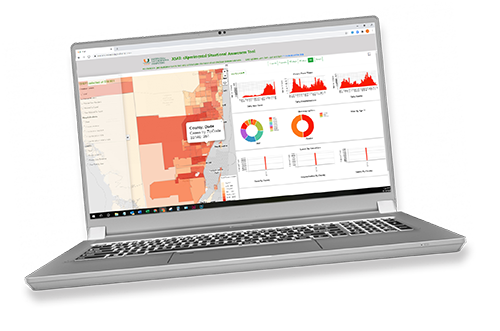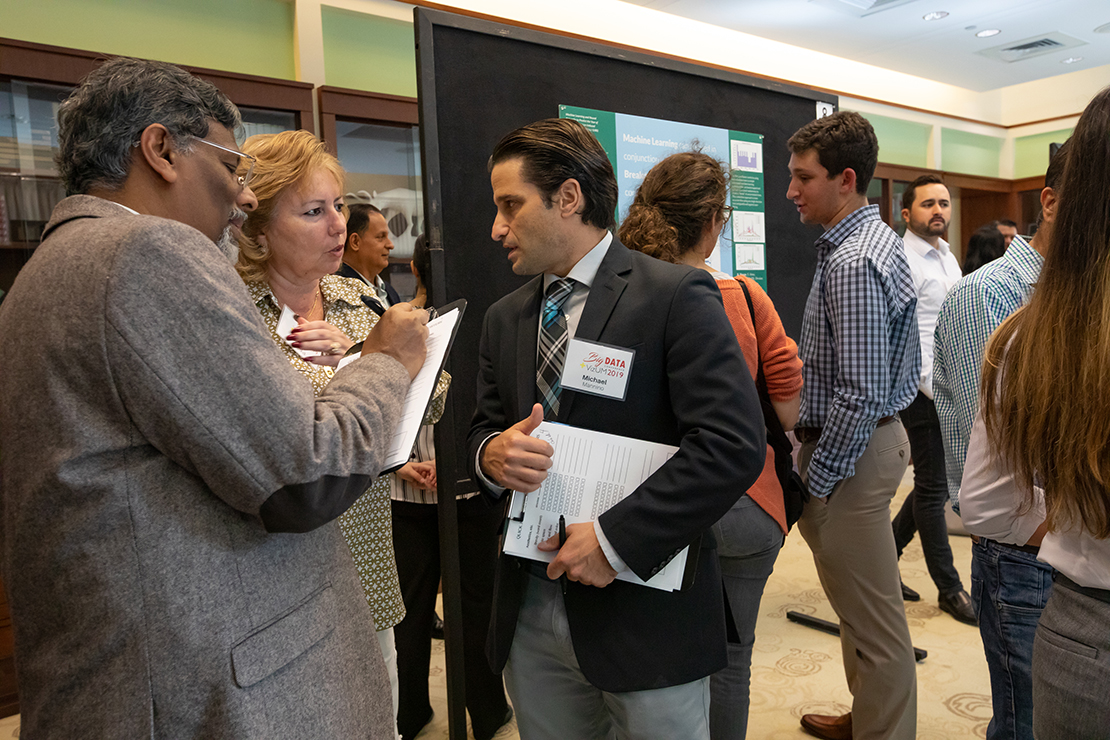 IDSC has developed a first-of-its-kind early-detection platform xsat.idsc.miami.edu for COVID-19 that will enable local residents to self-report symptoms and researchers and decision makers to visualize data and identify hot spots. By tracking social media posts, analyzing public health data, and creating an interactive online dashboard, University of Miami researchers, and others, will have the ability to identify new clusters of COVID-19 cases in real time, rather than days or weeks after an outbreak.
IDSC has developed a first-of-its-kind early-detection platform xsat.idsc.miami.edu for COVID-19 that will enable local residents to self-report symptoms and researchers and decision makers to visualize data and identify hot spots. By tracking social media posts, analyzing public health data, and creating an interactive online dashboard, University of Miami researchers, and others, will have the ability to identify new clusters of COVID-19 cases in real time, rather than days or weeks after an outbreak.
“With COVID-19, we need to get ahead of the curve, not just flatten it,” said Nick Tsinoremas, PhD, Founding Director of IDSC and Vice Provost for Research Computing and Data. “This important public health initiative is also designed to quickly identify new infectious disease problems in the future.”
Funded with a rapid response grant from the University of Miami Office of the Vice Provost for Research, the early-detection platform is being deployed in Miami-Dade County, but will expand to include data from other geographic areas. “We want to provide health care leaders, physicians, and the public with timely data for making decisions,” Tsinoremas said. “Our xSAT (eXperimental Situational Awareness Tool) platform will compliment the contact tracing systems that focus on individuals who test positive for the coronavirus.”
 A Web-Based Application
A Web-Based Application
For the xSAT platform, the IDSC team built a web-based situational awareness application that makes it easier to explore the data related to an infectious disease outbreak, said Chris Mader, IDSC Director of Software Engineering. “We are taking COVID-19 data from multiple sources and giving users a variety of ways to visualize the information,” he said.
For instance, the dashboard can show the locations of recent cases, sorted by age, gender, and other variables. It also can separate Florida residents from visitors to help determine if infections were related to travel. Residents may find xSAT useful in seeing how the outbreak is affecting their neighborhood while the application’s “Emerging Clusters” feature could help decision makers direct tracking, tracing, and other resources. Each tool includes maps, graphs, tables, and interpretations of the data on an interactive dashboard.
“In terms of scale, we can cover the entire state for some types of data or look at individual Miami-Dade neighborhoods for other information.” Mader said, adding that the application can also generate alerts to indicate new cases. “We are bringing geospatial and clinical data together so they be examined at the same time.”
Social Media Posts
Along with the clinical data, the early-detection platform brings in the human element through social media posts. “We are correlating the COVID-19 cases with feeds on Twitter, Instagram, Facebook, Reddit, and other sites,” said Joel Zysman, Director of Advanced Computing at IDSC. “We also plan to deploy a self-reporting application available via mobile devices.”
 To train the University’s Triton supercomputer to identify local COVID-related posts, Zysman said his team created a data set based on pandemic-related posts from New York. “Now that we’ve trained the machine on data we know is good, even a few hundred Miami-Dade posts will allow us to draw meaningful conclusions,” he said. “There are many reasons one can have a fever or a cough, but if many people are feeling ill in certain neighborhoods, that’s a good indication for health authorities to take a closer look.”
To train the University’s Triton supercomputer to identify local COVID-related posts, Zysman said his team created a data set based on pandemic-related posts from New York. “Now that we’ve trained the machine on data we know is good, even a few hundred Miami-Dade posts will allow us to draw meaningful conclusions,” he said. “There are many reasons one can have a fever or a cough, but if many people are feeling ill in certain neighborhoods, that’s a good indication for health authorities to take a closer look.”
Designed to reflect Miami-Dade’s demographic diversity, Zysman noted that the xSAT platform’s database includes Spanish and Haitian-Creole posts, in addition to English. “We don’t want to over- or under-represent COVID-19 cases in any neighborhoods,” he said. “We are also being careful to adjust for population density, as there will be more cases in urban than in rural areas.”
Without IDSC’s supercomputing resources, Zysman added, the early-detection platform could not sort through the vast trove of de-identified clinical data and social media posts. “Triton provides the horsepower for applying machine learning techniques and artificial intelligence (AI) strategies to the early detection issue,” he said. “In the emerging field of infodemiology, AI, natural language processing, and sentiment analysis can be used to track positive and negative affect, as well as geospatial clusters of symptoms.”
Engaging the Community
Tsinoremas said the interdisciplinary project integrates expertise from a variety of fields, including Computer Science, Information Engineering, Statistics, and Data Science. “We also want to mobilize the communities within the University, South Florida, health providers, and the public, to collaborate in the continued development and use of this powerful interactive platform. We look forward to working with many partners and stakeholders to make this first-of-its-kind initiative the most useful it can be.”

xsat.idsc.miami.edu
Tags: Advanced Computing, Chris Mader, Coronavirus, COVID-19, Joel Zysman, Nick Tsinoremas, Situational Awareness Tool, Software Engineering, Tracking App, Web Applications, xSAT, xSAT eXperimental Situational Awareness Tool




Comments